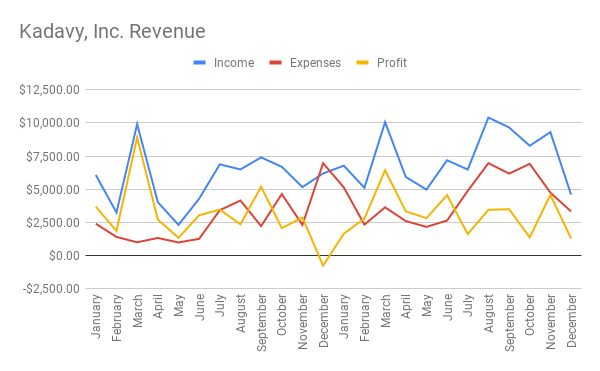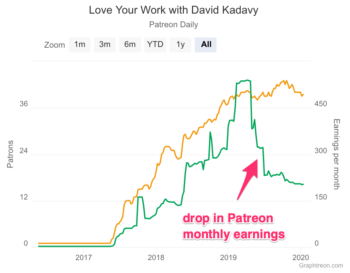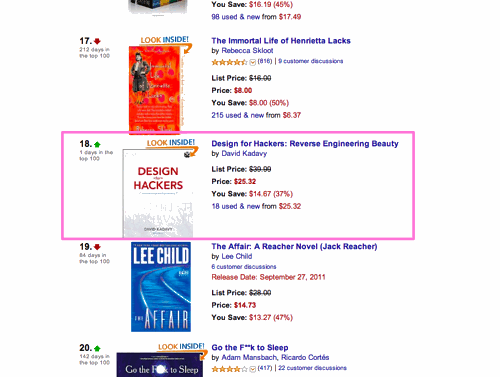Subscribe to blog updates via email »
December 2019 Income Report
An audio version of this income report is available to Patreon backers of certain levels »
December’s revenues were $4,594, down from November’s $9,308. Profits were $1,278, down from November’s $4,570.

WANT TO WRITE A BOOK?
Download your FREE copy of How to Write a Book »
(for a limited time)
December may look like a bad month. After all, revenue was half that of November’s, and profits were almost a third.
But, there are a couple of factors that make December not nearly as bad as it seems. In fact, December was very good in some ways.
One factor is that December is always a high-expense month. Like many business owners, I delay as many yearly payments as possible until December. That way I have that little extra money leftover to grow my business throughout the year.
In December, I paid a year up-front to ActiveCampaign, Dropbox, Hootsuite, Quickbooks Online, and Zapier. Those together add up to more than $2,000 in expenses.
Compare this December’s profit to last December’s profit. In December 2018, I lost $773. This December, I made a $1,278 profit. So, that’s an improvement.
Record self-published books profit
Another factor that makes this month not as bad as it seems is ad spend. My revenue was over $9,000 in November in part because I spent a lot of money on Amazon ads, as I had been doing as of late.
But on November 25th, I shut off all Amazon ads. I kept them off all the way through December.
I made nearly $2,000 in self-published book royalties in December, and that was pure profit! The income and ad spend lines on the graph went way down, but the profit line went up.
My previous record-profit month for self-published books was $1,350, in July 2018. This month, I’m reporting “only” $1,605 in profit on self-published books. This is because I report ad spend on a cash basis, while I report book sales on an accrual basis.
In actuality, I made $1,993 on self-published books, and spent nothing on advertising those books. Despite the fact that I shut off Amazon ads on November 25th, I paid for some of my past ads within the month of December. I hadn’t realized that Amazon had that much of a delay in billing, but now I know!
Amazon Ads, I don’t need you
I shut off Amazon Ads, because I was losing money for the first time. I was shocked to discover that I didn’t need the ads in order to sell books. I had my record-profit month in book sales, after all!
This brings me back to the question I was asking myself when I was first spending $5,000+ per month on ads: Would I rather spend nothing on ads, and make $2,000 in profit, or would I rather spend $5,000 on ads, and still make $2,000 in profit?
The answer for me is still the latter. I would rather spend $5,000 in ads, and make $2,000 in profit. That would be more book sales and further reach. Not to mention that I still would like those 3x credit card points for more free flights to visit family in the wake of my mother’s death.
However, as of yet, I haven’t been able to make that kind of profit while spending that much money.
It’s worth noting that I wasn’t especially scientific or disciplined about my ad spend. I was primarily trying to sell as many books as possible without losing money. It’s also worth noting that much of the profits that I’m enjoying are probably a delayed benefit from spending a lot on ads. Also, I did run a pricing promotion in late November/early December, which boosted my sales. Finally, the holiday shopping season, and upcoming New Year probably helped book sales, too.
But, since the data from Amazon Ads is so hard to tie back to ad sales, it was nice to get a clean slate, and see how many books I can sell without those ads at all. It has opened up some creative energy to think about other ways to sell books. For example, I plan to run pricing promotions on a schedule in 2020, and promote some promotions only to new readers on my list, and promote other promotions to as many people as possible.
Mixing Amazon Ads back in slowly
I’m slowly mixing some Amazon Ads back into my marketing efforts. I have the “Performance” campaign for How to Write a Book running, and have cut many of my bids.
WAB concludes with a sample chapter of HTS. So, it will be interesting to see if any boost in sales for WAB results in any of that “read through” I hear fiction authors talk so much about.
Upping my Twitter game
I came to a startling realization the other day: I’ve published well over 30,000 tweets over the past twelve years.
And out of all of those tweets, I’ve almost never had a hit.
I had to admit something to myself: I’m bad at Twitter.
Of course, being “bad” at Twitter depends upon how someone measures success. You don’t have to publish “hit” tweets to be “good” at Twitter. Over the years, Twitter has helped me have conversations with my readers, and test out thoughts.
But I thought it was a good time to re-think my Twitter game. I clearly use Twitter a lot. It’s my favorite social media platform.
Twitter is for testing ideas
So if I’m going to keep using Twitter, what do I want to get out of it? What is Twitter for? Once I decide what Twitter is for, I can then try to do a better job.
I decided that the primary thing Twitter is for is this: Twitter is for testing ideas.
Secondary to that, Twitter is for growing my audience – primarily for growing my email list, for the sake of selling more books.
That’s what Twitter is for. But I wasn’t using Twitter as if that was what it was for.
I’ve been using Twitter wrong
Primarily, I was using Twitter as a distraction. It was a “reward” after a work session. Yes, I was using Twitter to “test ideas,” but I wasn’t making a good effort at that.
I would have an idea, then I would tweet it. Then I would watch to see if likes, retweets, or replies came in.
I had long before deleted the Twitter app from my phone, but I was still checking it frequently, without thinking, on my laptop. I was also occasionally signing in – and staying signed in – on my mobile browser.
I decided it was time to change. It was time to see if I could do Twitter well.
Doing what’s good for me, not what’s good for Twitter
If you’ve followed my writing the past several years, you know that I’m not a fan of the attention economy. I think most people don’t realize just how much damage it’s doing to society that so many of us are spending so much energy on social media.
But, Twitter is a useful platform, it’s a platform I know well, and if people are spending time there, I can market my work to those people.
Twitter is a business, and businesses want certain things in order to stay in business. Those things that businesses want for themselves aren’t always good for the people who use their products.
In my quest to begin using Twitter well, I decided to operate according to one principle: Do what’s good for me, not what’s good for Twitter.
Here’s what Twitter wants:
- Twitter wants page views, and time spent on their platform. The more they have of these things, the more advertising they can sell.
Here’s where what’s good for me overlaps with what’s good for Twitter:
- If I can write tweets with a lot of engagement, Twitter will help more people see those tweets, because it’s good for Twitter.
- If lots of people see my tweets, I can grow my audience, sell more books, and therefore keep writing.
Here’s where what’s good for Twitter is not good for me:
- It’s good for Twitter if I’m spending a lot of time on their platform. But the more time I spend on Twitter, the less time I have for other things.
- By extension of that, it’s good for Twitter if I’m watching my replies. But the more I watch my replies, the less time I have to do other things.
- By extension of that, it’s good for Twitter if I tweet a lot. They don’t care if my tweets suck. Maybe some will be good, and that’s all that matters. They have lot of tweets to choose from. But if my tweets suck, I’m wasting my time writing them.
Since Twitter doesn’t care if my tweets suck, there’s one final area where there are things that are bad for me, but that Twitter is indifferent to: Twitter doesn’t care how much thought I put into my tweets.
I do put some thought into my tweets, but I don’t put a lot of thought into my tweets. I always compose them right in that little box on the Twitter website.
Once I’ve written my tweet, all I have to do is click on “tweet”, and away it goes.
If I were good at Twitter, would I use it the way I do?
With this thought process, I came to one question: If I were using Twitter for testing ideas and selling books, would I use it the way I use it?
The answer was a resounding, “NO!”
Primarily, if I were truly trying to write good tweets – tweets that had the purpose of testing ideas – I would put much more thought into those tweets.
I would not publish tweets moments after thinking about them.
I would not compose tweets right in the publish box.
I sure as hell would not waste hours a day monitoring the performance of my shitty tweets.
Developing better tweets
As such, I have been conducting an experiment so far in 2020. I have started working harder on my tweets, and I have started spending very little time on Twitter’s website.
To start, I signed out of Twitter on my laptop and my phone. I stopped checking Twitter on impulse, with the help of some mental tricks – which I of course tweeted:
8 things I can do in 2020 when I feel the urge to check social media:
1. Read one page of a book
2. Text a friend
3. Call Dad
4. Breathe deeply one time
5. Look at nature
6. Think of something I’m grateful for
7. Write down an idea
8. Triage an inbox— ? David Kadavy | Time ?? Mind Management (@kadavy) January 3, 2020
Importantly, I also stopped publishing tweets the moment they came to me. Whenever I get an idea for a tweet, I no longer open up Twitter to publish it.
Instead, I write the idea down. I write it down on my pocket notebook, a whiteboard I have lying around the house, or even on the waterproof notepad I have in my shower.
I also periodically work on developing these ideas into tweets. I keep an Evernote note, called “Tweets in Development.” My ideas are sorted into: Inbox, Developing, Incubate, Rejects, and Published.
In this note, I brainstorm. I play with wording. I experiment with different formats. I split hairs about different ways a tweet can be interpreted. I think about why someone would or wouldn’t retweet or like a tweet.
When I feel that a tweet is ready to be published, I do not then go to Twitter to publish it. I instead put it into Buffer, where it will be published somewhere between hours and days from the time I put it into Buffer.
It obviously requires some discipline for a Twitter junkie such as myself to wait to publish tweets, but I’ve had plenty of practice in this with my podcast and Love Mondays newsletter. I schedule this other content to be published way ahead of time, such that when they go out, I’m not even thinking about it. So, I try to think of tweets the same way I would an email newsletter or a podcast episode.
Checking Twitter with intention
If Twitter is for testing ideas, and I’m spending more time developing those ideas, eventually I need to see if those ideas are doing well.
So, I do check Twitter periodically. But, I do so with intention.
Currently, I’m checking Twitter twice a week: Once on Tuesday afternoon, and once on Friday afternoon.
I’ve been experimenting with different processes for checking Twitter. I start by going directly to my timeline, to see how the tweets have performed. I also check in my Analytics section to see more exact engagement and impression numbers. I then look at my replies – and try to reply to as few of them as necessary. Finally, there are some Twitter users who I think use Twitter well whose timelines I visit directly, to study their tweets.
Analyzing my actual Twitter performance (i.e. what Twitter doesn’t want you to know)
Since I’m being intentional about what Twitter is for, and trying to do a better job at it, naturally, I want to know how I’m doing.
So, when I check Twitter, I monitor my performance to see if my ideas are performing well, and if I’m getting better at writing tweets.
Interestingly, Twitter makes this very difficult. Sure, they’ll show you some performance metrics in their “Analytics” section, but I’m realizing that what they show is what’s good for them to show you, not what’s good for you to know.
Notice that the “impressions” graph is front and center in Twitter’s Analytics dashboard.
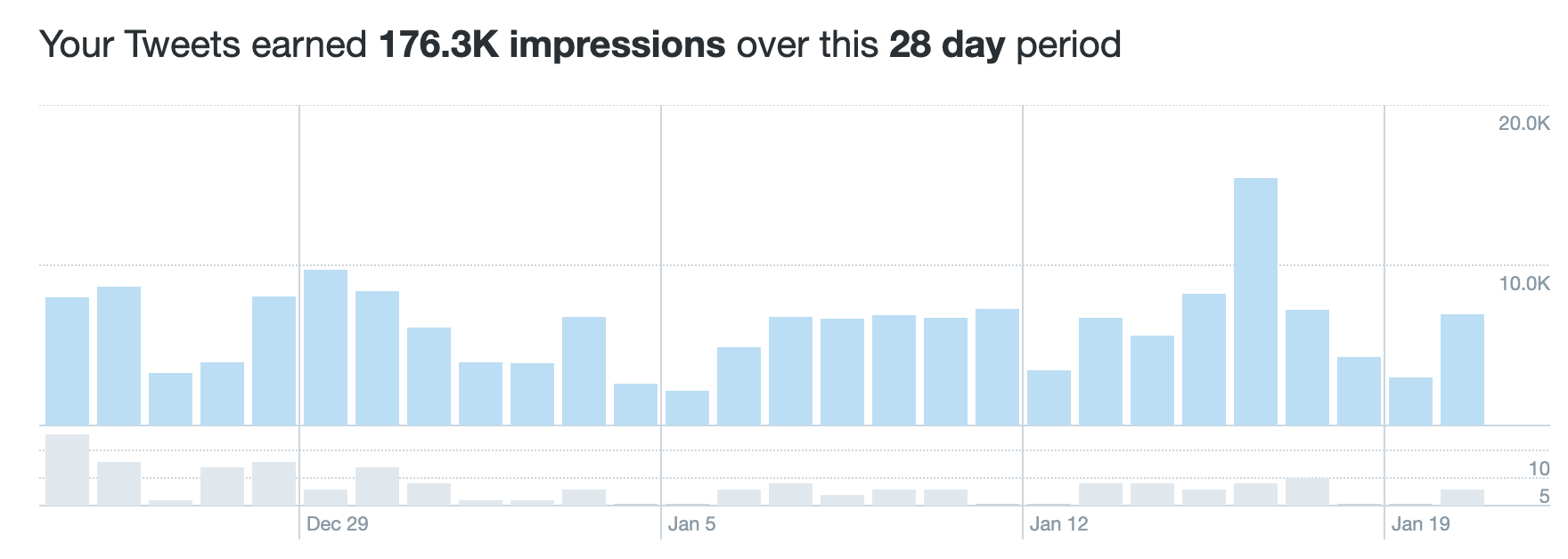
Twitter’s Analytics dashboard focuses on total number of impressions – a stat that doesn’t help you improve your tweets.
Twitter also stresses “engagement rate.”

“Engagement rate” sounds like a helpful stat, but how it’s actually calculated is a mystery to me. I want to know engagement rate per tweet!
This “engagement rate” is mysterious, because I can’t tell how they calculate it, over time.
If I’m trying to do Twitter well, I’m not so much interested in the total number of impressions, or the total number of engagements. I’m interested in the number of impressions or engagements per tweet.
Now, the name “engagement rate” implies that it’s based upon the number of engagements per tweet, but that doesn’t seem to be the case.
What Twitter does let you do, is export your data and analyze it for yourself. So, that’s what I did.
Look at the graph I created using Twitter’s “engagement rate” metric. To prevent distortion from very good or very bad tweets, I built this and following graphs based upon the 7-day average.
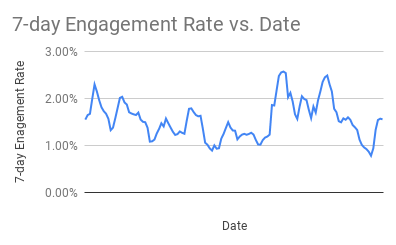
A graph I created of the 7-day moving average of my Twitter “engagement rate” – whatever the that means.
Now, look at the graph of number of retweets per tweet.
And here’s my likes per tweet.

Likes per tweet. Again, notice the recent improvement, not reflected in the “engagement rate” graph.
Finally, look at my number of impressions per tweet.
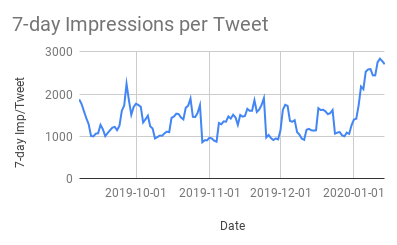
Impressions per tweet. Notice, again, the recent improvement, again, not reflected by the “engagement rate” graph, nor Twitter’s total “impressions” graph.
By any measure that I would deem important in my efforts to write better tweets, I’m improving immensely. The number of retweets and likes per tweet have quadrupled. Each tweet is getting double or triple the number of impressions as the previous baseline.
But according to Twitter, my performance isn’t improving at all. That’s what Twitter “wants” me to think, anyway. They want me to spend more time on their platform, and to write more tweets.
But what I want is to have more engagements per tweet. If I have more engagements per tweet, that means I have fewer poor tweets. I retain followers better, and spend less time on the platform – and more time working on writing better tweets, which will ultimately make me a better writer.
Judging by my own analysis, my Twitter-improvement program is working very well. One caveat is that I’m currently losing followers, by a small margin. But I don’t think that’s a metric that can be trusted on such short notice. I have been consistently losing, then gaining, an equal number of followers for a couple of years now. I think many of my followers are inactive or bots – as reflected by engagement numbers that are relatively low.
If I can keep improving my tweets, I believe I will begin to gain followers. At the very least, I’ll become a better writer.
Studying rhetoric
I’m not simply spending more time on my tweets. I’m also trying to be deliberate about making my tweets better.
One thing I’m doing along the way is studying rhetoric. It turns out that there are patterns in language that any good writer will intuit eventually, and the Greeks came up with names and rules for those patterns thousands of years ago.
When you have names and rules for these patterns, you can be more intentional about using them, and write better tweets.
This book has been a great introduction to rhetoric. I’m also digging into this book, which has a more engaging and reader-friendly format.
Additionally, some of these rhetorical forms tie into formats of tweets that perform well. So, I’m beginning to analyze those forms as well, and try to use them in my tweets.
I haven’t gotten it all figured out yet. If I do, I’ll find some way to share what I’ve learned.
D4H Video webinar sales
The sales from the webinar I ran in December are in this report. Remember, I booked $1,106, of which $838 fell in December (the rest of the revenue will come in the form of monthly payments).
Two years of The Heart to Start
The Heart to Start has now been out for two years. Here are the numbers so far:
- Copies sold: 14,518 (+3,000 free)
- Total Royalties: $52,939
- Advertising Expense: $45,521
- Fixed Production Costs: $556
- Profit: $6,862
Selling almost 15,000 books is a good showing. HTS is starting to catch up with D4H, which has been out for nine years now.
However, less than $7,000 profit on those 15,000 is less than I had ever expected. D4H still creams HTS in terms of profit.
Here are the numbers for HTS for 2019:
- Copies sold: 6,243
- Total Royalties: $33,745
- Advertising: $30,098
- Additional Fixed Production Costs: $125
- Profit: $3,522
Pretty close to last year’s numbers. I sold fewer copies in 2019 because I charged more. I also spent twice as much on ads to make those sales.
Hardcover edition of The Heart to Start
One thing that has cut into HTS profits is the $125 I spent on an ISBN number for the hardcover edition.
The hardcover version of HTS I ordered through Amazon Prime the other day arrived today. Not a bad turnaround during the holidays! pic.twitter.com/ectnJFhs9B
— ? David Kadavy | Time ?? Mind Management (@kadavy) December 25, 2019
The hardcover edition is now available on Amazon! I even ordered it on Amazon Prime while I was in The States, and it showed up within a few days. Not bad during the holidays!
Unfortunately, Amazon is showing “ships in 1 to 2 months” for the hardcover edition – which isn’t true!
I reached out to IngramSpark support, and they blamed Amazon. I reached out to Amazon support, and they blamed IngramSpark.
So, I’m hoping that ship date will get fixed at some point, and I haven’t yet done anything to promote the hardcover. Therefore, I haven’t had much chance to recoup that $125 expense for the ISBN number.
I can see why Amazon wouldn’t want to bother fixing the ship date – I’m not sure how they make any money off of those sales. Whatever they make, it’s probably less than they make selling their own POD paperbacks.
This snag calls into question my plans to launch my next book as a hardcover. Getting a feel for snags like this was part of the motivation for creating a hardcover edition of HTS in the first place.
2019 in review
At the end of last year, I hoped to publish more short reads, to improve the “synergy” of my content-creation process, and to increase my ActiveCampaign referrals.
I did publish some more short reads, including Ten Passive Income Ideas, In Defense of Papyrus, and a couple other perma-frees.
I definitely improved the “synergy” of my content-creation process. I now have a reliable creative system for delivering my weekly Love Mondays newsletter. That process is tying in nicely to the existing creative system for podcast production.
I did indeed grow my ActiveCampaign referrals – by 84% ($15,372 in 2019, vs $8,374 in 2018), thanks in part to a detailed ActiveCampaign review that I produced. That recurring, passive income is freeing up mental energy to create things.
I did experience a burn when I travelled all the way to San Francisco – at my own expense – to be on a big podcast, only to have the episode not run.
And the biggest tragedy I’ve experienced in my life happened in 2019, when my mother died unexpectedly and suddenly from a brain hemorrhage, caused by a rare vascular malformation, called an AVM.
2019 vs. 2018
2019 and 2018 were very similar, in terms of profit. I reported $37,299 in profit in 2019, according to the accounting methods of these income reports. in 2018, that number was $36,639. An extra $600 in 2019. Nothing to get excited about.
If I described 2018 as a “lean year”, as far as numbers are concerned, I can’t say 2019 was a whole lot better.
I spent a lot on ads in 2018, but I spent way more in 2019. In 2018, I “only” spent $18,442, and in 2019, I spent double that: $37,241.
Here’s the breakdown of income and expenses for 2018, vs. 2019:
| 2018 | 2019 | Difference | |
| Income | $68,624 | $88,748 | $20,124 |
| Expenses | $31,985 | $51,449 | $19,464 |
| Profit | $36,639 | $37,299 | $660 |
And here’s the breakdown of income, by category:
| Category | 2018 | 2019 | Difference |
| Book Sales | $26,509 | $47,023 | $20,515 |
| Affiliates | $17,043 | $21,409 | $4,367 |
| Digital Products | $12,371 | $12,179 | -$193 |
| Services | $4,219 | $2,431 | -$1,788 |
| LYW Podcast | $8,169 | $5,706 | -$2,463 |
There was a gain in affiliate sales, helped by the boost in ActiveCampaign referrals, dampened by a drop in Amazon affiliate income, and an overall less diverse profile of affiliate income sources than 2018.
Book sales were much higher, but then there was that extra ad spend, which ate up most of the extra profits. The growth in profits from self-published books was only slight. $6,757 this year, over last year’s $6,461. 4.6% growth, with 102% more ad spend.
Services income was cut almost in half – primarily because I didn’t cash in any Steemit earnings (I haven’t been active there lately).
Disappointingly, the podcast income was quite a bit lower. I made almost 40% more on Patreon in 2019 than I did in 2018 – more than an $1,100 difference. I also made an additional $382 in PayPal donations.
That’s a good thing, however, Patreon support has dropped as of late.
As I mentioned as it was happening, it was disturbing to see the “crisis bias” that Patreon has. When I was going through visa troubles, my backing skyrocketed.
I of course had an even bigger crisis in 2019, with my mother’s death, but I was less open about that with my podcast audience, and it unsurprisingly had no detectable effect on my Patreon support.
Despite the increase in Patreon backing, I had way less advertising income for the podcast in 2019. My advertising podcast income for 2019 didn’t come close to touching that for 2018. $1,270, versus $5,147.
On the plus side, I spent no time looking for advertisers. I suppose I could have run more ads if I had chosen to focus my efforts on that. Also, it’s good to have a higher percentage of my podcast earnings come from listener support, rather than from advertisers!
A decade in review
With this new year, we have a new decade, so some kind of decade-in-review is in order.
At the start of the decade, I was earning decent passive income for the first time. That was freeing me up to explore other things. It was August 2010 when Wiley reached out to me to see if I would be interested in writing Design for Hackers.
I knew that it wasn’t going to be the most lucrative move I could make in my career, but I was up for the challenge. Everyone advised me to foray it into getting bigger and better design clients. I, however, saw it as a stepping stone to more books.
Writing Design for Hackers was a life-changing experience. It debuted at #18 on all of Amazon.
Suddenly, I was being invited to speak all over the world. I spoke in more than a dozen cities in the U.S., and in a total of eight countries worldwide.
The primary thing I worked on for the decade was looking back on how difficult it was to write my first book, and trying to make the creative process less painful.
As I go into 2020, I’m almost ready to present what I’ve learned over the last decade, with my next book. The current title is Mind Management, Not Time Management, based upon the blog post I wrote in 2012, which connected me with Dan Ariely and Timeful, which later sold to Google.
To round out the decade, after a long struggle in coming to terms with what I really wanted, I spent the past four years in Colombia, working on my podcast Love Your Work, which launched at the end of 2015. At the end of 2017, I published The Heart to Start, my first self-published book.
What’s in store for 2020?
As for what I want to accomplish in 2020, I really just want to get this book published. After a 2018 riddled with visa troubles, and the death of my mother and resulting chaos in 2019, I really just hope for a year without some major catastrophe. But, I know that this is life, and I don’t have control over that.
I also hope to get even more “synergy” going in my content creation process. I think this concerted effort at getting better at Twitter will help me sharpen my messaging, and test ideas out so that I can have a more cohesive content-creation process, while shipping ideas that are more resonant. That should help me grow my audience and sell more books, so I can write more books!
Income
Book Sales
Digital Products
| White Hot Course | $101 |
| D4H Video | $838 |
| Summer of Design | $9 |
| Total Digital Products | $948 |
Affiliates / Advertising
| Active Campaign | $1,129 |
| Amazon | $65 |
| ConvertKit | $62 |
| Google Adsense | $144 |
| SendOwl | $5 |
| Total Affiliates | $1,404 |
Love Your Work Podcast
| Patreon | $198 |
| PayPal Donations | $10 |
| Total LYW Podcast | $208 |
Services
| Medium | $15 |
| Clarity | $25 |
| Total Services | $40 |
| GROSS INCOME | $4,594 |
Expenses
General
| Accounting | $220 |
| Outside Contractors | $144 |
| Podcast Editing / Publishing | $254 |
| Misc. Software | $439 |
| Total General | $1,056 |
Advertising
| Amazon | $374 |
| BookBub | $3 |
| $7 | |
| $5 | |
| Total Advertising | $389 |
Hosting
| ActiveCampaign | $1,377 |
| Bookfunnel | $15 |
| Dropbox | $120 |
| Genius Link | $10 |
| Hootsuite | $108 |
| Libsyn | $20 |
| Namecheap | $13 |
| SendOwl | $24 |
| Teachable | $20 |
| Zapier | $165 |
| Total Hosting | $1,871 |
| TOTAL EXPENSES | $3,316 |
| NET PROFIT | $1,278 |

